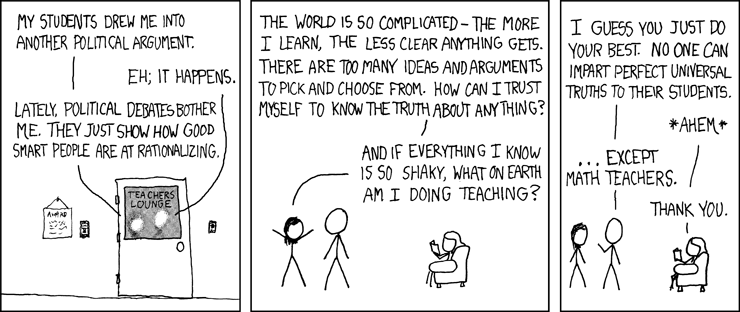Estraven at Proving Theorems wishes that mathematicians today spent more time revisiting and bring up to date older, more inaccessible works of mathematics. This is discussed in the context of a re-publication of some of Grothendieck's early work on schemes.
There's a lovely quote at the end of the article, one that I cannot but help share:
I could of course keep writing paper after paper. But there is so much beautiful mathematics out there that I don't know yet, and I want to read at least some of it before I dieI remember first sensing beauty when I first learnt Burnside's Lemma: Leadhyena Inrandomtan at Viviomancy has a detailed post on this simple, and yet elegant result in combinatorics.
Burnside's Lemma ultimately deals with counting symmetries: Ian Stewart has a new book out on the history of symmetry titled, "Why Beauty is Truth: A History of Symmetry". In a post at the Brittanica blogs, he describes why he decided to write this book.
In an ongoing series, John Amstrong continues his unapologetic look at coloring knots. I'd say any topic that has phrases like 'involuntary quandle' is worth studying. Of course, the original tying-yourself-in-knots proof was the diagonalization method of Cantor, which Mark Chu-Carroll is kind enough to explain to us, while he takes a timeout from beating errant creationists with sticks of logic. Mark notes that he's been going back to some old books on Set theory and is thoroughly enjoying them, another example of the theme of the day :)
Godel's incompletenes theorem is another of the tying-yourself-in-knots variety, and this year's Godel prize winner is a result in the same vein, showing why certain "natural proof structures" cannot be used to prove P != NP. Siva and Bill Gasarch have the scoop.
Walt at Ars Mathematica catches up to the Bulletin of the AMS, highlighting some nice expository articles that should make Estraven happy.
It's time to get educational now. Dave Marain helps high school math teachers everywhere with lesson plans for teaching quadratic systems and tangents without calculus. Mikael Johansson shows bravery far above and beyond the call of duty, explaining fundamental groupoids to a group of 9th graders. Heck, I don't even understand what a groupoid is, and I read John Baez all the time !
jd2718 shows his students how Fermat is connected to them. It would be remiss of me not to give a shout out to the Mathematics Genealogy Project. We've all heard the horror stories about the students who write "dy/dx = y/x"; Dan Greene at The Exponential Curve talks of students who write "log 5/log 2 = 5/2" and wonders if we need to change the notation for log to something more "mathematical".
I am delighted, and surprised, to see the quality of reports produced in the undergraduate
automata class that Leo Kontorovich is TAing. Read more about what his students did here. Andy Drucker weaves tales (tails?) of dogs eating steak in mineshafts, and cats climbing GMO-compromised trees, to explain some of the subtler details of computability theory.
We're almost ready to wrap up this edition of the carnival. Chew on some simple brainteasers that will excercise regions of your brain that you may not have known existed ! And review the history of calculating devices, with some speculation on what future calculators might look like.
Finally, no carnival of mathematics would be complete without a cartoon by XKCD:
And that's all, folks ! Keep those posts coming. The next Carnival of Mathematics is in two weeks, hosted by JD2718.

Great carnival and thanks for including SharpBrains!
ReplyDelete